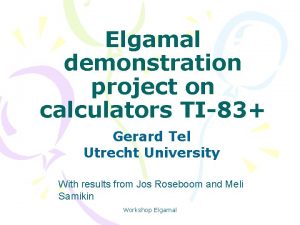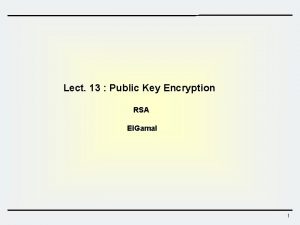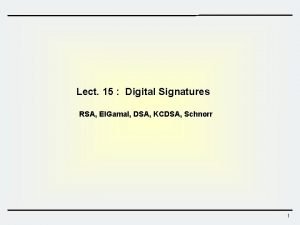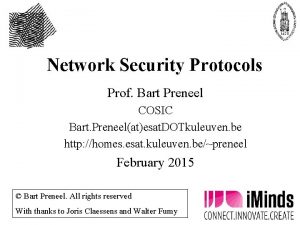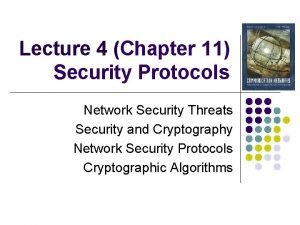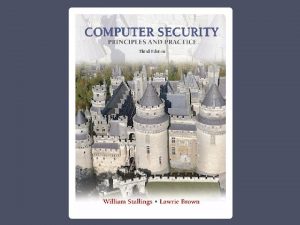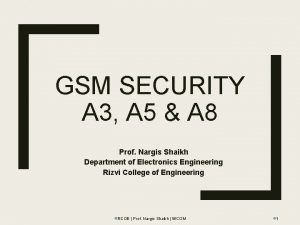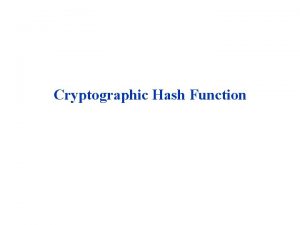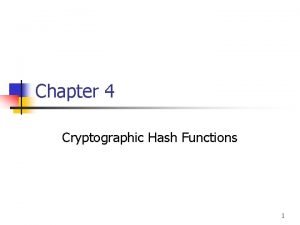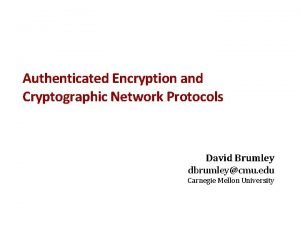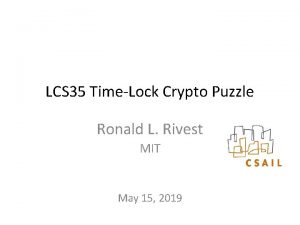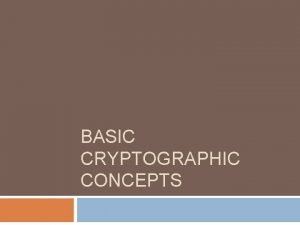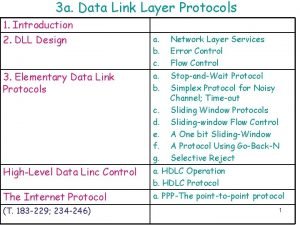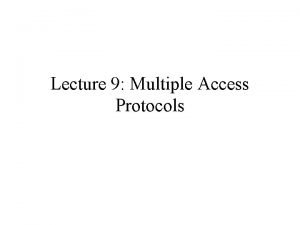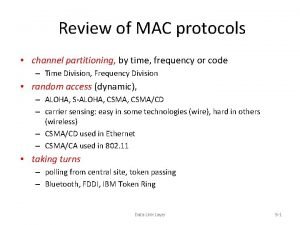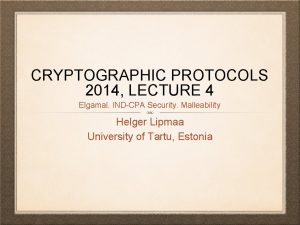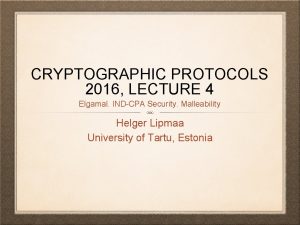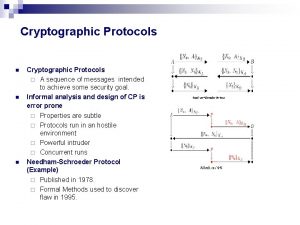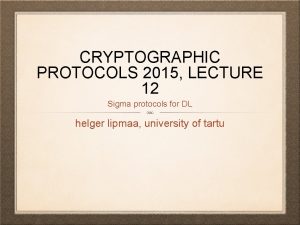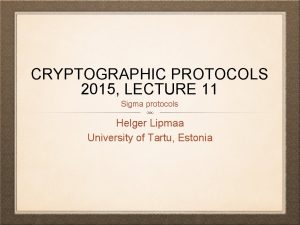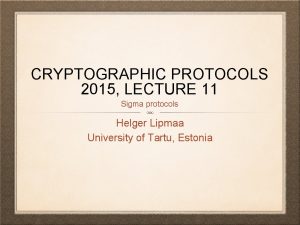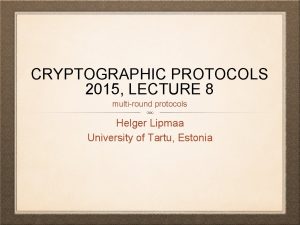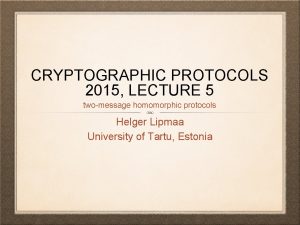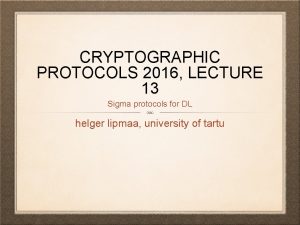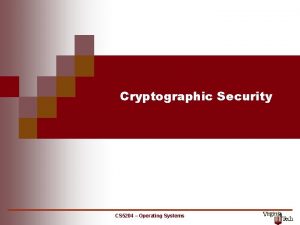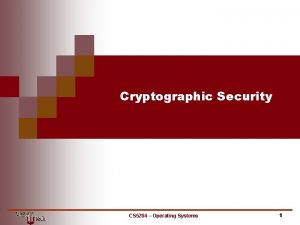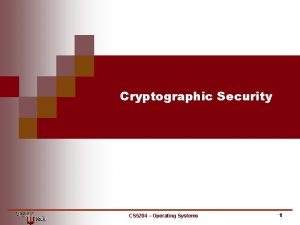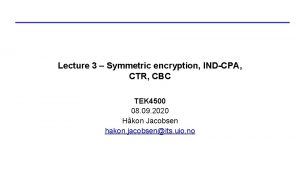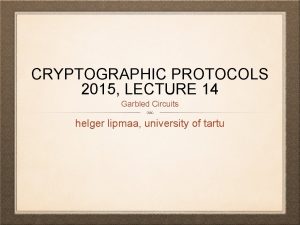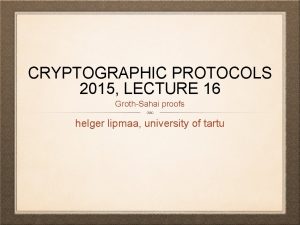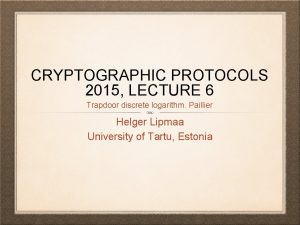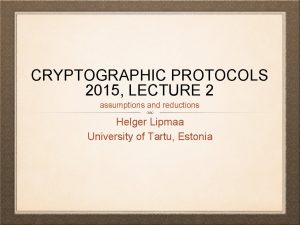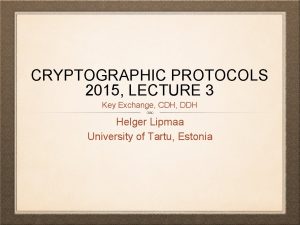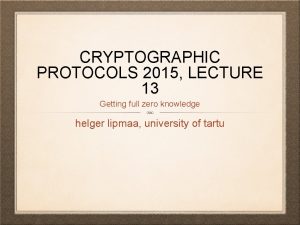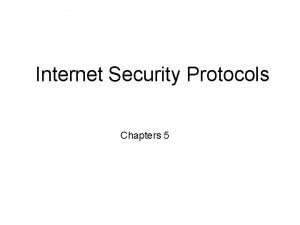CRYPTOGRAPHIC PROTOCOLS 2015 LECTURE 4 Elgamal INDCPA Security

























![IND-CPA SECURITY Π = (Setup, Keygen, Enc, Dec) Game IND(κ, Π, A) Adv[IND] : IND-CPA SECURITY Π = (Setup, Keygen, Enc, Dec) Game IND(κ, Π, A) Adv[IND] :](https://slidetodoc.com/presentation_image_h2/43ea14a1b80311c80526795c4e9d5e0a/image-26.jpg)
















- Slides: 42

CRYPTOGRAPHIC PROTOCOLS 2015, LECTURE 4 Elgamal. IND-CPA Security. Malleability Helger Lipmaa University of Tartu, Estonia

UP TO NOW Assumptions, reductions Basic assumptions in DL family: DL, CDH, DDH (DH)KE. Security of KE <=> assumptions Owners of public keys can agree on joint secret key

REMINDER: KEY EXCHANGE I want to send secret information to Bob, but he is in Jamaica Let us agree on a joint secret key for further communicat ion

SECURE COMPUTATION I want to know whether I have more hash than Bob but I do not want to reveal how much I have Let us do secure computati on of "≥" Millionaires' protocol Ditto

SECURE COMPUTATION sk, pk, a 1 Encode a by using pk (pk, Encode (pk; a)) 2 Compute f(a, b) on "encoded" inputs 3 Decode by using sk, obtain f (a, b) c = Encode (pk; f (a, b)) Million dollar question: how

QUIZ: SECURITY OBJECTIVE sk, pk, a 1 Encode a by using pk (pk, Encode (pk; a)) 2 Compute f(a, b) on "encoded" inputs 3 Decode by using sk, obtain f (a, b) c = Encode (pk; f (a, b)) ?

QUIZ: SECURITY OBJECTIVE sk, pk, a 1 Encode a by using pk (pk, Encode (pk; a)) 2 Compute f(a, b) on "encoded" inputs 3 Decode by using sk, obtain f (a, b) c = Encode (pk; f Answer: (a, b))Alice and Bob should ? not trust each other. Here Alice may want to learn Bob's input, and Bob may want to learn Alice's input. Will formalize the next lecture

THIS LECTURE: MODULARIZATION Top-down approach: good when you already know the field, and there are enough primitives/assumptions available Assumption Primitive Protocol DDH, . . . Encrypt, garble, . . . Millionaires', . . . We find an existing encoding that looks suitable We have a goal Make the necessary assumption

THIS LECTURE: MODULARIZATION We know assumption We build some encoding on top of it We build the final protocol on top of it Assumption Primitive Protocol DDH, . . . Encrypt, garble, . . . Millionaires', . . . Bottom-up approach: good for teaching, research (easier to start with basics) and getting papers published

THIS LECTURE: MODULARIZATION We know assumption We build some encoding on top of it Assumption Primitive DDH Elgamal (homomorphic encryption) Encrypt Bottom-up approach: good for teaching, research (easier to start with basics) and getting papers published

REMINDER: KEY EXCHANGE t, f←gᵗ s, h = gˢ h f sk=SK(s, f) = sk sk=SK(t, h)

REMINDER: ONE-TIME PAD sk, m sk c ← m ⊕ sk m←c⊕sk (m⊕sk)⊕sk=m⊕(sk⊕sk)=m

HOW TO COMBINE We have key-exchange Returns secret key sk₁. . . and one-time pad Returns ciphertext, given sk₂ However, they work in different domains sk₁ is a group element, sk₂ is a bit-string

ONE-TIME PAD IN A GROUP sk, m∈G sk c ← m · sk m* m←c / sk Quiz: what property of groups is needed for decryption to work? m? ?

SECURITY INTUITION If sk is uniformly distributed in G, then m · sk is also uniformly distributed For all m ∈ G*, c ∈ G: Pr [m · sk = c] = Pr [sk = c / m] = 1 / q Thus, an adversary who only sees c, has no information about m

ELGAMAL ENCRYPTION h One-time keys public key h Long-time keys sk←SK(r, h) s, h=gˢ r, gʳ, m (c₁, c₂) ←m(· sk, gʳ ) sk←SK(s, gʳ) m ← c₁ / sk

ELGAMAL ENCRYPTION Elgamal. Setup (κ): hb 1. Choose a group G of order q where One-time keys breaking DDH hassk←SK(r, pk) complexity 2^κ 2. Choose a generator g of G 3. Return gk ← desc (G) = (. . . , q, g) r, h←gˆr Elgamal. Keygen (gk): Long-time keys 1. s ← ℤq 2. pk = h ← gˢ 3. Return (s, h) /* secret key, public key sk, pk */ (c₁, c₂) ←m(· sk, h) Elgamal. Enc (gk, h; m, r): Elgamal. Dec (gk, s; c₁, c₂): 1. /* Assumes r ← R: randomized alg. */ 2. (c₁, c₂)←( mhʳ, gʳ) 3. Return (c₁, c₂) 1. m ← c₁ / c₂ ˢ 2. Return m For the sake of simplicity, we assume that gk is a fixed system parameter, shared by all participants. Will not mention gk unless explicitly needed

CORRECTNESS: FORMALLY Key generation: h = gˢ Encryption: (c₁, c₂) = Ench; (m, r) = (mhʳ, gʳ) Decryption: c₁ / c₂ ˢ = mgʳˢ / gʳˢ = m Thus decryption is always successful

SECURITY: INTUITION Elgamal = DHKE + one-time pad DHKE is whatke-secure under X assumption one-time pad is unconditionally secure => Elgamal is whatenc-secure under X assumption But how to formalize?

QUIZ: SECURITY pk h s, h=gˢ r, h←gʳ, m (c₁, c₂) ←mhʳ, ( gʳ ) m ← c₁ / c₂ ˢ ?

ENCRYPTION SECURITY: ISSUES Message recovery security: Eve should not be able to compute m Just difficulty of computing m is not good enough Like KR security was not enough in KE Need indistinguishability again

QUIZ: SECURITY pk h s, h=gˢ r, h←gʳ, m (c₁, c₂) ←mhʳ, ( gʳ ) m* m ← c₁ / c₂ ˢ m*=m or garbage ?

REAL-RANDOM / LEFT-RIGHT Real-Random indistinguishability: Adversary cannot distinguish the real plaintext m from a random plaintext Encrypt "I owe Even if she has chosen m herself 100$"or else Left-Right indistinguishability: Adversary cannot distinguish a random ciphertext of m₀ He encrypted from a random ciphertext of m₁ "start a Even if she has chosen both m₀ and m₁ herself battle"or "do not start a battle". Which one?

QUIZ: WHICH NOTION IS STRONGER Answer: equal Rando m 1 (RR hard =>LR hard) If can distinguish left from right, then one of them must be distinguishable from random 2 (LR hard => RR hard) If the adversary cannot distinguish any two chosen messages (e. g. , one of them can be random), he cannot distinguish one chosen message from random Left Right Notions are equal, standard approach: assume LR security since it is intuitively harder (gives adversary possibility to choose both messages)

Chosen-Plaintext Attack QUIZ: IND-CPA SECURITY pk h r, h←gʳ e←{0, 1} ( , ₀ m ) ₁ m s, h=gˢ (c₁, c₂) ←mₑhʳ, ( gʳ ) e* mₑ ← c₁ / c₂ ˢ e* = e ?
![INDCPA SECURITY Π Setup Keygen Enc Dec Game INDκ Π A AdvIND IND-CPA SECURITY Π = (Setup, Keygen, Enc, Dec) Game IND(κ, Π, A) Adv[IND] :](https://slidetodoc.com/presentation_image_h2/43ea14a1b80311c80526795c4e9d5e0a/image-26.jpg)
IND-CPA SECURITY Π = (Setup, Keygen, Enc, Dec) Game IND(κ, Π, A) Adv[IND] : = | Pr[IND = 1] - 1 / 2 | A ε-breaks IND-CPA security of Π iff Adv[IND] ≥ ε Π is (τ, ε)-IND-CPA secure iff no adversary ε-breaks IND-CPA security of Π in time ≤ τ Π is IND-CPA secure iff it is (poly(κ), negl(κ))-IND-CPA secure gk ← Setup (κ) (s, h) ← Keygen (κ) (m₀, m₁) ←A (h) e ← {0, 1} r ←R c ← Enc (h; mₑ, r) e* ← A (h, c) Return e = e* ? 1 : 0

ELGAMAL IS IND-CPA SECURE Theorem. If G is a (≈τ, ≈ε)-DDH group, then Elgamal is (τ, ε)-IND-CPA secure in G. Proof idea. Reduction to absurd: we show that if Elgamal is not secure in G, then DDH must be easy in G. Elgamal is not secure => there exists an adversary D that breaks Elgamal We show DDH is easy by constructing an adversary C that breaks DDH C can use help from adversary D, by sending inputs to D and receiving outputs Simple, a home exercise

. . . TAUTOLOGY Theorem. If Elgamal is (τ + small, ε)-IND-CPA secure, then G is (τ, ε)-DDH group. (Thus, equivalent) Proof idea. Reduction to absurd: we show that if DDH is not secure in G, then breaking Elgamal must be easy in G. DDH is not secure => there exists an adversary D that breaks DDH Show Elgamal is easy by constructing an adversary C that breaks Elgamal C uses help from adversary D, sending inputs to D and receiving outputs

MAIN IDEA Recall: h = gˢ, (c₁, c₂) = Enc (h; m, r) = (mhʳ, gʳ) Hence (g, h, c₂, c₁) =(g, gˢ, gʳ, mgʳˢ) If m = 1: (g, h, c₂, c₁) is a random DDH tuple If m = random: DDH assumption: indistinguishable (g, h, c₂, c₁) is a random non-DDH tuple since random * anything = random in cyclic group

REDUCTION: DDH <= ELGAMAL Challenger (desc(G), h) s← ℤq; h ← gˢ e ← {0, 1}; r← ℤq; (c₁, c₂) ←mₑhʳ, ( gʳ ) (m ₀, m₁) (c₁, c₂) C (desc(G) , g, h, c₂, c /* just forward */ ₁) Correct distributi on for DDH (? ) e * else return 0 e* D (m₀, m₁) ← (1, random) if e* = e return 1 Need to construct return e* /* some comp */

Assume D works in time τ and is successful with prob. ε + 1 / 2 REDUCTION: DDH <= ELGAMAL Challenger s← ℤq; h ← gˢ e ← {0, 1}; r← ℤq; (c₁, c₂) ←mₑhʳ, ( gʳ ) (desc(G), h) C If D is unsuccessful then C is ₁) m , ₀ successful with prob. 0, and takes (m (desc(G) time τ* , g , h , c₂, c₁) /* just forward */ (c₁, c₂) Correct distributi on for /* some comp */ D (m₀, m₁) ← (1, random) DH (? ) e Pr[C*successful] = ε + 1 / 2 if e* = e return 1 else return 0 If D is successful then C is Need to construct successful and takes. Dtime τ* =τ + small e* return e* Thus, if Elgamal is (τ*, ε)-IND-CPA secure, then G is a (τ, ε)-DDH group

IND-CPA AND BEYOND Actual security requirements even more stringent IND-CPA security only demonstrates basic concepts Bob must be sure c really came from Alice Crypto is full of Authentication, non-malleability trade-offs: do we want malleability or not? In protocol design, malleability is very useful

MALLEABILITY m f(m) Modifying ciphertexts, without knowing the secret key, so that the plaintext changes predictably Essential for secure computation

MALLEABILITY OF ELGAMAL Recall: Enc (h; m, r) = (c₁, c₂) =mhʳ, gʳ) ( Enc (h; m, r) · Enc (h; n, t) = Enc (h; m · n, r + t) (mhʳ, gʳ) (nhᵗ, gᵗ)= (mnhʳ ⁺ᵗ, gʳ ⁺ᵗ) Componentwise multilication

HOMOMORPHIC ENCRYPTION efficient (C, C) M Enc efficient (Enc, Enc) (M, M) · · C efficient Similar to isomorphism, except randomized efficient

SOME COROLLARIES Recall: Enc (m, r) · Enc (n, t) = Enc (m · n, r + t) We omit h (public key) for brevity in what follows 1. Πᵢ Enc (mᵢ; rᵢ) = Enc (Πᵢ mᵢ; Σᵢ rᵢ) 2. Enc (m, r)ˢ = Enc (mˢ, sr) for public s ∈ ℤq 3. Πᵢ Enc (x� ; rᵢ)^fᵢ = Πᵢ Enc ((x�)^ fᵢ; fᵢrᵢ) = Enc (Πᵢ (x�)^ fᵢ; Σᵢ fᵢrᵢ) Polynomials have a sum instead of product and product instead of exponentiation evaluating public "polynomial" at secret point

QUIZ: ENCRYPTING INTEGERS Elgamal makes it possible to encrypt group elements Question: how to encrypt (short) integers? Answer: Lifted Elgamal: use exponentiation (isomorphism) Enc' (m ∈ ℤq, r) = Enc (gᵐ, r) Dec' (c₁, c₂) = dlog g (Dec (c₁, c₂))

SOME COROLLARIES 1. Πᵢ Enc' (mᵢ; rᵢ) = Enc' (Σᵢ mᵢ; Σᵢ rᵢ) 2. Enc' (m, r)ˢ = Enc' (sm, sr) for public s ∈ ℤq 3. Πᵢ Enc' (x�; rᵢ)^fᵢ = Πᵢ Enc' (fᵢx�; fᵢrᵢ) = Enc' (Σᵢ fᵢx�; fᵢrᵢ) Σ� f (x) evaluation of public polynomial at secret point 4. Πᵢ Enc' (xᵢ; rᵢ)^yᵢ Enc'(z; t) = Enc' (Σᵢ xᵢ yᵢ + z; Σᵢ yᵢrᵢ + t) - arbitrary affine functions with public yᵢ, z

LIFTED ELGAMAL: MORE Enc, Dec --- efficient Lifted Elgamal useful when L is small: L ≤ 2^40? dlog exp efficient Dec' can be computed in time Θ (√ L) when input is from {0, . . . , L - 1} ℤq G G₁ Dec Enc' efficient, Dec' inefficient Enc efficient G 2 efficient inefficient

SUMMARY One can "compute" on Elgamal ciphertexts Plaintexts are group elements More useful: lifted Elgamal However, only efficient for small plaintexts limited malleability Secret computation of arbitrary affine functions in ℤq that have small outputs

STUDY OUTCOMES Secure computation: idea Modularization Elgamal IND-CPA security Malleability, homomorphic encryption Lifted Elgamal, its limitations

WHAT NEXT? Examples of concrete protocols quite cool non-trivial stuff can be done within given severe limitations Formalization and proof of their security
 Grafical calculator
Grafical calculator Elgamal encryption java
Elgamal encryption java Dsa vs rsa digital signature
Dsa vs rsa digital signature Security security security
Security security security Network security protocols
Network security protocols Playfair cipher
Playfair cipher Categories of attacks
Categories of attacks 01:640:244 lecture notes - lecture 15: plat, idah, farad
01:640:244 lecture notes - lecture 15: plat, idah, farad Cryptographic tools
Cryptographic tools Pin punctures steganography
Pin punctures steganography Cryptographic attacks
Cryptographic attacks Cryptographic hash functions
Cryptographic hash functions Cryptographic
Cryptographic Military cryptographic equipment
Military cryptographic equipment Owasp top ten most critical web application vulnerabilities
Owasp top ten most critical web application vulnerabilities Insecure cryptographic storage challenge 2
Insecure cryptographic storage challenge 2 Cryptographic
Cryptographic Cryptophage
Cryptophage Koi 18
Koi 18 Cryptographic concepts
Cryptographic concepts Network security essentials 5th edition
Network security essentials 5th edition Ambuj varshney
Ambuj varshney Insecure cryptographic storage challenge 3
Insecure cryptographic storage challenge 3 Computer security 161 cryptocurrency lecture
Computer security 161 cryptocurrency lecture Wireless security in cryptography and network security
Wireless security in cryptography and network security Security guide to network security fundamentals
Security guide to network security fundamentals Visa international security model
Visa international security model Integrity in e commerce
Integrity in e commerce Osi security architecture in network security
Osi security architecture in network security Electronic mail security in network security
Electronic mail security in network security Building security software
Building security software Guide to network security
Guide to network security Cnss model 27 cells example
Cnss model 27 cells example Security guide to network security fundamentals
Security guide to network security fundamentals Fokus secara kolektif terhadap pembelajaran murid
Fokus secara kolektif terhadap pembelajaran murid Stop-and-wait arq
Stop-and-wait arq Wireless lan protocols
Wireless lan protocols Define nursing protocols
Define nursing protocols Chapter 3 network protocols and communications
Chapter 3 network protocols and communications What are two pitfalls (problems) of lock-based protocols
What are two pitfalls (problems) of lock-based protocols Determine the taxonomy of multiple access protocols
Determine the taxonomy of multiple access protocols Go back n
Go back n Channel partitioning mac protocols
Channel partitioning mac protocols
